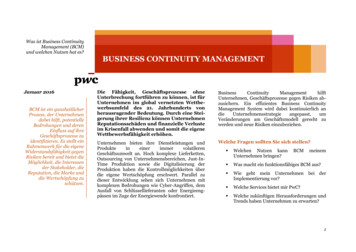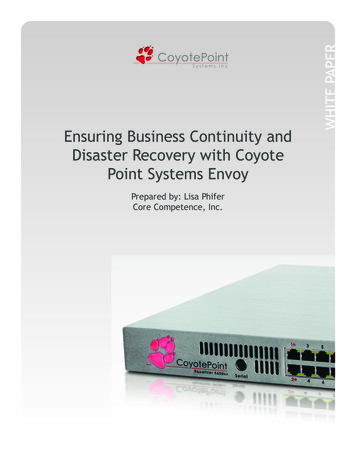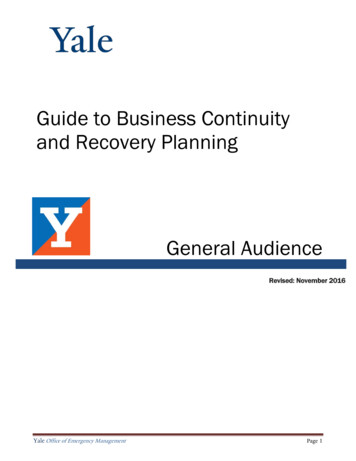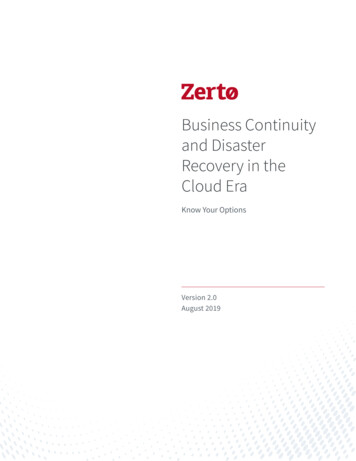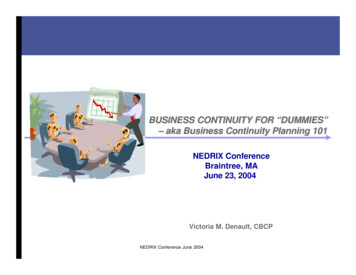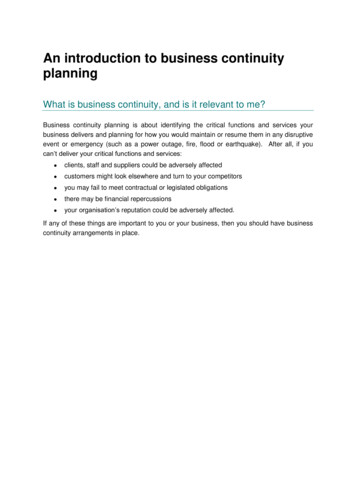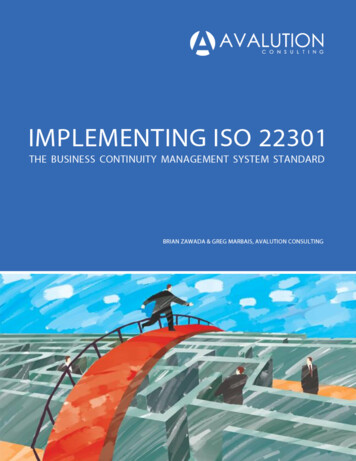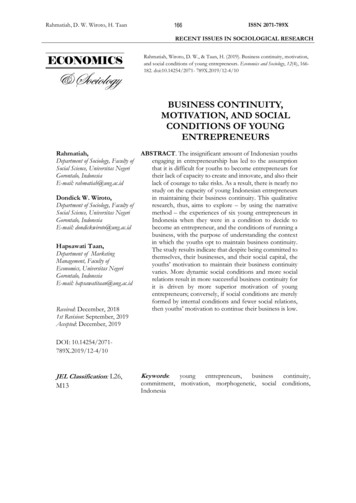
Transcription
166Rahmatiah, D. W. Wiroto, H. TaanISSN 2071-789XRECENT ISSUES IN SOCIOLOGICAL RESEARCHRahmatiah, Wiroto, D. W., & Taan, H. (2019). Business continuity, motivation,and social conditions of young entrepreneurs. Economics and Sociology, 12(4), 166182. doi:10.14254/2071- 789X.2019/12-4/10BUSINESS CONTINUITY,MOTIVATION, AND SOCIALCONDITIONS OF YOUNGENTREPRENEURSRahmatiah,Department of Sociology, Faculty ofSocial Science, Universitas NegeriGorontalo, IndonesiaE-mail: rahmatiah@ung.ac.idDondick W. Wiroto,Department of Sociology, Faculty ofSocial Science, Universitas NegeriGorontalo, IndonesiaE-mail: dondickwiroto@ung.ac.idHapsawati Taan,Department of MarketingManagement, Faculty ofEconomics, Universitas NegeriGorontalo, IndonesiaE-mail: hapsawatitaan@ung.ac.idReceived: December, 20181st Revision: September, 2019Accepted: December, 2019ABSTRACT. The insignificant amount of Indonesian youthsengaging in entrepreneurship has led to the assumptionthat it is difficult for youths to become entrepreneurs fortheir lack of capacity to create and innovate, and also theirlack of courage to take risks. As a result, there is nearly nostudy on the capacity of young Indonesian entrepreneursin maintaining their business continuity. This qualitativeresearch, thus, aims to explore – by using the narrativemethod – the experiences of six young entrepreneurs inIndonesia when they were in a condition to decide tobecome an entrepreneur, and the conditions of running abusiness, with the purpose of understanding the contextin which the youths opt to maintain business continuity.The study results indicate that despite being committed tothemselves, their businesses, and their social capital, theyouths’ motivation to maintain their business continuityvaries. More dynamic social conditions and more socialrelations result in more successful business continuity forit is driven by more superior motivation of youngentrepreneurs; conversely, if social conditions are merelyformed by internal conditions and fewer social relations,then youths’ motivation to continue their business is low.DOI: 10.14254/2071789X.2019/12-4/10JEL Classification: ity,commitment, motivation, morphogenetic, social conditions,Indonesia
Rahmatiah, D. W. Wiroto, H. Taan167ISSN 2071-789XRECENT ISSUES IN SOCIOLOGICAL RESEARCHIntroduction. The search for a sociological explanation on youths’ business continuityThis is a socioeconomic research on youth entrepreneurship. Entrepreneurial patterns inbusiness continuity generally do not receive much attention in sociology. Actions taken byentrepreneurs are substantial in order for their businesses to keep operating and expanding(establishing, maintaining, and developing business), which we often find in managementliterature as standalone phenomena, while in fact they may essentially be found throughsociological approaches, namely Margaret Archer’s theory of morphogenesis. MargaretArcher’s morphogenetic perspective emphasizes that actors have their respective life history(social relation-entrepreneur’s culture) indicating numerous changes (ideas, beliefs, values, andactions of entrepreneurs) that are beneficial in empowering and restraining them when theydesign their projects (including entrepreneurship) (Mole & Mole, 2010).Youths and other generations in the society undergo intense modernization processesthat are full of uncertainties (Furlong & Cartmel, 2007). Lewin (2012) mentions that uncertaintyis a situation that makes entrepreneurship possible, yet the capability of utilizing such uncertainconditions can only be specified as a capability possessed by stable MSMEs (capable ofmaintaining their competitive and comparative advantage), but not by newly establishedMSMEs (Wiroto, 2016). Unstable micro and small enterprise conditions would instead compelyouths to confront uncertain conditions and become potential job-seekers or entrepreneurs(Rahmatiah, Wiroto & Taan, 2017).Our prior study on several successful young entrepreneurs in Indonesia (Rahmatiah,Wiroto, dan Taan, 2017) found that they possess a number of ideal sociological factors that wecall the “four dimensions of young entrepreneur’s identity”, which are: experienced a triggeringincident that drove them to become entrepreneurs; create business plans and constantly improvethem; create various innovations; and have clear business implementation plan. Our priorresearch found that not all young entrepreneurs in Indonesia possess these four dimensions ofyoung entrepreneur’s identity as ideal sociological factors, even more so with the factors ofbusiness planning and entrepreneurship implementation. We have, subsequently, focus ourfurther research on understanding the processes undertaken by young entrepreneurs inGorontalo Municipality in order to survive and develop as entrepreneurs despite missing someof the four dimensions of young entrepreneur’s identity.Stemming from such a focus of this follow-up study and the morphogenetic approach,the aim of this research is to gain an understanding on the processes that the youth carried outto maintain own business continuity. Several hypotheses were made basing on the results ofour previous research. These hypotheses are:1. Continuity of youth’s business is determined by their ability to deal with various conditionswhen deciding to become an entrepreneur and conducting business processes. (H-1)2. Youth’s ability to deal with various conditions when deciding to become an entrepreneuris determined by their ability to make use of their social relationship background and theirbusiness knowledge for starting a business. (H-2)3. Youth’s ability to deal with various conditions when conducting business processes isdetermined by their ability to constantly gain profit and apply entrepreneurial principlesand values in the businesses they own (H-3).The discussion and results of this qualitative study show that our hypotheses arevalidated, they were even further developed, among others, due to the use of sociologicalconcepts of business continuity and research findings resulting in other sociological conceptsthat are relevant to business continuity such as commitment, motivation, and social conditions.
Rahmatiah, D. W. Wiroto, H. Taan168ISSN 2071-789XRECENT ISSUES IN SOCIOLOGICAL RESEARCH1. Sociological approach in issues of business continuityIn reality, although under significant conditions of uncertainty, there are still youngpeople opting to become entrepreneurs. The dilemma young people face in choosing to becomea potential job-seeker or entrepreneur classifies young entrepreneurs into two categories: thosedriven by the necessity to become an entrepreneur (necessity entrepreneurship); and thosedriven by the opportunity to become an entrepreneur (opportunity entrepreneurship) (Lippman,Davis, & Aldrich, 2005; Williams & Nadin, 2010). Opportunity entrepreneurship shows a moreadvanced endeavor than necessity entrepreneurship because the latter describes a person whobecomes an entrepreneur due to structural circumstances, namely having to survive and beingless fortunate in finding decent employment opportunities (Williams & Gurtoo, 2012) and forlack of any other choices than maintaining business operation (Grilli, 2010). Unfortunately, thisdivision is unable to show which of the two is better in maintaining business continuity.According to Max Weber, the entrepreneur principle is to control and calculate with maximumefficiency the entire means of production under a general management (Collins, 1980).Basically, young entrepreneurs should bear characters of modern capitalist entrepreneurs,particularly in gathering and optimizing organizational assets in order to avoid business failure(Bennet, 2016).Successful entrepreneurship may be understood in three ideal conditions ofentrepreneur, namely: the transition to entrepreneurship, followed by the entrepreneurshipprocess, and ultimately the entrepreneurship structure. At the micro scale, individuals transitioninto entrepreneurs because of their interactions with their external environments (individualinteractions with their interpersonal networks) allowing them to gain resources and informationderived from their social capital. Subsequently, the individual digs into their internal capabilityto change these resources into financial capital and information into human capital/motivationfor themselves to become an entrepreneur. The entrepreneur process enables them to gainbenefit and establish entrepreneur identity upon themselves. Ultimately, an entrepreneurshipmicro structure (the individual’s identity as an entrepreneur with more expansive interpersonalnetworks) is created, that is the availability of social capital that relates to business activitiesrequiring expenditures, and social capital beneficial to create the public’s trust in them (Ruef &Lounsbury, 2007). The sociological explanation regarding entrepreneurship is very helpful increating a frame of young entrepreneur’s success in maintaining their initial business, amongothers: because the entrepreneur strives to succeed in: (a) transitioning themselves to engage inentrepreneurship; (b) the entrepreneurship process of the business sector they run; and (c)forming an entrepreneurship structure of the business activities they have been running.The three categorization of an entrepreneur’s success stages will be much betterunderstood when coupled with the young entrepreneurs’ three basis of action identity(Rahmatiah, Wiroto, & Taan, 2017). The transition stage into entrepreneurship is a periodwherein youths come to a realization of the various life events they have, personally andcollectively, experienced and then utilized as resources to develop their self potential as anentrepreneur and initiate a commitment to achieve their dreams (young entrepreneurs’ first basisof action identity). A number of literatures strengthening the fact that youths’ success in thetransition to entrepreneurship are those stating that the human capital element is very crucial tothe business founder’s capability in maintaining business continuity, such as their young ageand being from a minor group that faces more risks than other entrepreneurs (Boyer & Blazy,2014), experiences of being involved in similar industry and business sector (Gartner, Starr, &Bhat, 1999; Englis, Ratinho, Englis & Harms, 2010; Mishra, 2005; Boyer & Blazy, 2014),formal education graduate (Dencker, Guber, & Shah, 2009; Mishra, 2005). Innovation, workexperience, and entrepreneurial network do not have much influence in the survival of one’s
Rahmatiah, D. W. Wiroto, H. Taan169ISSN 2071-789XRECENT ISSUES IN SOCIOLOGICAL RESEARCHbusiness (Englis, Ratinho, Englis, & Harms, 2010; Boyer & Blazy, 2014). Of no lesssignificance is an article written by Jaroslaw Korpysa, who emphasized that entrepreneurialzeal or enthusiasm to conduct business is very much determined by the support of family andfriends, source of funding for establishing the initial business, and market conditions (Korpysa,2019).The entrepreneurship process is a stage in which young entrepreneurs come to realizethat their commitment to achieve their dreams relates to better changes in human welfare, thusthey will constantly innovate and design business plans and models when they establish,maintain, and develop their business (young entrepreneurs’ second basis of action identity). Anumber of literatures reinforcing the fact that young entrepreneurs’ success in theentrepreneurship process, among others, relate to healthy financial condition in the companythat is most vital in business continuity, such as the availability of a financial managementsystem with levels of authority in the use of money and arrangement of business income (Boyer& Blazy, 2014), so that the business can have sufficient amount of money to pay for itsobligations (Huyghebaert, Gaeremynck, Roodhooft, & Van de Gucht, 2000). Healthy financialcondition means that the company should be able to constantly fulfill the required raw materialsand resources in order for the company to continue to generate products and services (Mishra,2005; Coad, Frankish, Robert, and Storey, 2016). It is better to use general productioncomponents, including for raw materials, which is included as a good entrepreneurship processfor business start-ups (Arichbald, Possani, & Thomas, 2003). Denoo, Yli-Renko, & Clarysse(2015) expound that new business continuity may also be caused by changes in business model,including paying attention to the products and services offered to the buyers, if they were to bechanged in order to maintain and increase sales (Dencker, Guber, & Shah, 2009).The formation of an entrepreneurship structure is a stage wherein young entrepreneurscome to realize that their business must have the potential to grow and develop, and for thatreason they constantly try to maintain the trust of their users, clients, and investors, and continueto enhance their business appeal (young entrepreneurs’ third basis of action identity). Severalbusinesses fail in this stage of entrepreneurship structure. The failure of SME businesses,according to Monk (2000), is mostly caused by SMEs inability to utilize essential managementand business practices. SMEs frequently misdiagnose problematic areas and needs in theirbusinesses. Subsequently, an example is provided indicating that businesses can survivebecause the management pays attention to quality and customer satisfaction (Cannon &Edmonson, 2001). Such capacity can only be achieved if entrepreneurs are willing to learn(Cannon & Edmonson, 2001; Atsan, 2016; Bennet, 2016) to improve their competitiveadvantage and continue to seek new businesses by establishing synergic relations with largerorganizations.2. An outlook of young entrepreneurs in Indonesia, most of whom are in the micro sectorIndonesia continues to experience entrepreneurship growth, yet in the wake of suchprogression there is the challenging capacity to maintain business, even more so to businessactors who are novices in the business world when they established their initial business.Results of company/business registration conducted by Indonesian Statistics (BadanPusat Statistik – BPS) in the 2016 Economic Census (BPS, 2016) provided data that Indonesiaexperienced an increase in business between 2006 – 2016, as much as 17.51% (from 22.73million to 26.71 million businesses). The amount of businesses in 2016 was dominated by smalland micro enterprises (SMEs) numbering at 26.26 million businesses (98.33%). SMEs absorbedas much as 76.28% of employment with the largest portion found in three business fields: first,retail and wholesale trade; automobile and motorcycle maintenance and repair (28.45%);
Rahmatiah, D. W. Wiroto, H. Taan170ISSN 2071-789XRECENT ISSUES IN SOCIOLOGICAL RESEARCHsecond, manufacturing industry (13.29%); and third, accommodation and food and beveragesprovision (11.09%).The 2016 Indonesian Youth Statistics issued by BPS indicates that youths were mostlyemployed in the following top four types of employment: as manual labor and cleaningpersonnel, as services and sales staff in shops and traditional markets, as labor in agricultureand animal husbandry, and as laborers in manufacturing and handicrafts. Most youths workedin these three business sectors: trade, restaurant, and accommodation; agriculture; and services.This establishes a strong assumption that youths largely work in SME sectors.The Indonesian youth population in 2016 was 62.06 million, wherein 10.87 million ofthem (17.53% of the total Indonesian youth population or 4.2% of the 257.9 million Indonesianpopulation) were young business owners, they might have conducted their own business, theymight have been assisted by unpaid labor or assisted by permanent/paid labor (this data wasobtained by sorting out the 2016 Indonesian Youth Statistics). The majority of young businessactors in Indonesia were 25-30 years of age and graduated from middle and high schools. basedon this data we can assume that young entrepreneurs on average were entrepreneurs in SMEsector with low level of education. On page 75-76 in the 2016 Indonesian Youth Statistics, BPSpresents their view that the low percentage of young entrepreneurs was due to the lack inyouths’ capacity to innovate and create, as well as their lack of courage in taking risks, resultingin their being dependent on working for others to achieve their future aspirations. This alsoshows the youths’ low level of entrepreneurship spirit produced by the prevailing formal basiceducation.The rise in the number of entrepreneurs in Indonesia does not necessarily meanincreased prosperity for the entire Indonesian population. Given that there is no clear data onthe rise and fall of small and micro enterprises in Indonesia, the quantity of new and survivingSMEs is, thus, beyond our understanding. The above data merely reinforce our interest, becausethe number of surviving small and micro enterprises was at more than 98% despite theentrepreneurs having minimum level of education and knowledge. This means that there is apossibility that these business actors had undertaken various natural processes to continue theirefforts of becoming an entrepreneur.3. Research methodologyThis study employed the qualitative research method as a logical consequence ofutilizing Margaret Archer’s morphogenetic theory which puts great emphasis on socialprocesses and qualitative changes. This study did not use the entire structure-agency-culturerelation as it only emphasizes the agency element, i.e. the entrepreneurs’ experiences in theirrelations with social and culture structures (ideas, beliefs, values, and actions of theentrepreneurs) that serve as a reference in examining the continuity of their current business.Consequentially, this study employed the narrative research method on six entrepreneurrespondents residing in Gorontalo Municipality and analyzed their experiences in establishing,maintaining, and developing their business. The six entrepreneurs interviewed were: RA, ownerof a furniture store (with 5 existing branches) and a side business of selling used cars; SM,owner of a mobile phone shop; YH, owner of a shop that sells cakes and biscuits known as oneof Gorontalo’s specialties and also owner of 6 mini market outlets; JT, owner of a drugstoreand health clinic; AL, boutique owner and trend setter of Karawo (apparels made fromGorontalo traditional handcrafted cloth); and NB, owner of a restaurant serving local Gorontalodishes who had represented Gorontalo in a national culinary competition of local Indonesiandishes in 2017. Aside from NB, the age of the five respondents could no longer be categorizedas young, they did, however, begin their business at a young age (below 30).
Rahmatiah, D. W. Wiroto, H. Taan171ISSN 2071-789XRECENT ISSUES IN SOCIOLOGICAL RESEARCHThis study does not only intend to show the life journey of entrepreneurs and theirbusinesses, but—by employing the narrative research method (Czarniawska, 2004)—it alsointends to gain a holistic understanding of their life by arranging the narratives of theirexperiences in order to perceive their social actions of transforming their experiences inconfronting highly unpredictable circumstances, even their failures, into facts that these aresignificant achievements in their life as an entrepreneur. Bloom (1996) via Merriam (2002)categorized the function of personal narratives as data, social criticism, and deconstruction—the narratives made from in-depth interviews function as data: materials for constructing anunderstanding on the transition of a young individual into an entrepreneur, which subsequentlywill be beneficial as a critical review and deconstructive instrument on the concept of youngentrepreneur’s success.The research instrument employed was the interview guideline developed based on theconcept of the four dimensions of Indonesian young entrepreneurs’ identity (Rahmatiah,
business continuity generally do not receive much attention in sociology. Actions taken by . Archer’s morphogenetic perspective emphasizes that actors have their respective life history (social relation-entrepreneur’s culture) indicating numerous changes (ideas, beliefs, values, and .
